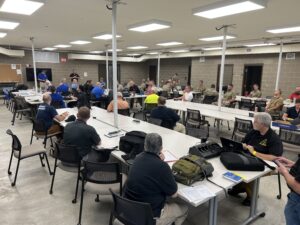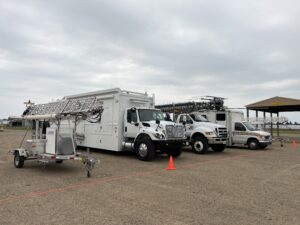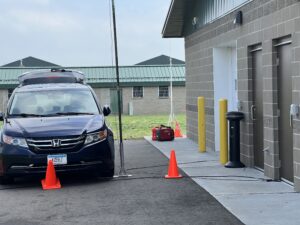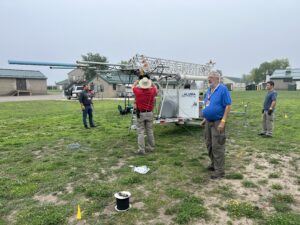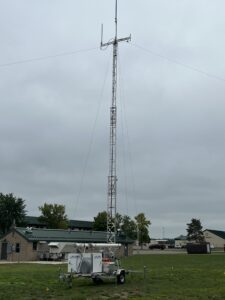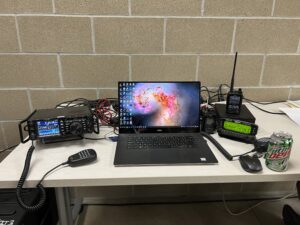MN-ECN COMMEX 2023 “NorthStar”
Benton Jackson, K0BHJ, AUXC, COMT
MN ARES Section Emergency Coordinator
The MN Emergency Communications Network (MN-ECN) held a communications exercise at the Camp Ripley national guard base August 21st-24th. This was the third time this exercise has been held, and the first where amateur radio was included in the plan from the beginning.
This is my personal journal; it is not an after-action report. I’m only reporting the events I know about, and I don’t remember all the people involved. There was a lot going on and I was only one part.
Last year, I was invited as ARES Section Emergency Coordinator as an observer, but I had a prior commitment. They were unable to meet one of their objectives, but it turned out a few of the participants were AuxComm (Auxiliary Communicator, or the FEMA resource AUXC) and had amateur gear with them. They were able to complete the objective on amateur radio. This was a great reminder that amateur radio is always a good thing to include in a communications plan.
This year, AuxComm was part of the plan. At least 7 of the invited participants were AUXC, including me. We were told to bring HF and VHF/UHF gear, for voice, WinLink, and DMR, with D-star as a plus. We were all assigned as participants. My goal was to learn how experienced emergency management teams do exercises in an ICS (incident command system) structure, and to show AuxComm and amateur radio in a good light.
On Sunday, I loaded up my van with all the ham radio gear I had that wasn’t bolted down, and even some that was. I was equipped to do everything on the list that was asked for except D-Star.
Monday was mostly classroom and planning. Then we went over our capabilities and were assigned to teams, got a review of ICS forms and WebEOC. The cellular providers gave a talk on the capabilities they were bringing. After lunch, we were briefed on the scenario, which was providing communications for a drone exposition at the nearby county fairgrounds. Just when we were just about done planning for that, we got our first event- there was a major storm in the fictitious town of “Johnsonville”, in the other direction, which was now severely flooded, knocking out all communications. Team 1 was assigned to Johnsonville, my team (2) was reassigned to cover the EOC, and team 3 was assigned to cover the drone event, which would continue without interruption. After a quick debriefing (known as a “hotwash”), that was it for the day.
We got a new situation briefing on Tuesday morning. The weather forecast was for hot and humid in the afternoon, with a heat index over 105. Marlyn Halverson, the Incident Commander, set a threshold of 100 degrees to call of the exercise for the day. There was a new event- an F-16 had shot down a UFO, and team 4, the national guard team, was sent to take care of that. The AUXC were assigned to Team 1 and Team 2. The AUXC on Team 1 were Gordy Hanson, N0ZRD, John Dalin, KA0MYG, and Alex Peterson, K0APR. The COML (communications leader) for Team 1 was Mike Wisniewski, KC0TAF, also an AUXC. Gordy left me with his portable UHF repeater, and then Team 1 left for “Johnsonville”. Team 2 consisted of myself, Bret Erickson, K0BOC, and Chris Schultz, KC0YFX. Chris was also a COMT (communications technician), and he was assigned to that role, tasked with setting up an ARMER (MN public safety radio) console for the Incident Management Team. Brett was assigned to the ARMER radio for the EOC team. I didn’t really have anything to do and was feeling at a loss, when our team COML, Eli Charif, told me to start setting up ham radio gear “just in case” we were needed.
OK- now I know what to do- play radio! I set up a VHF/UHF antenna on a 10 foot pole and my mobile radio from home to access the local VHF repeater and Packet WinLink. There were no VHF WinLink gateways in range, but Johnsonville was in simplex range, so we were able to exchange WinLink test messages. I also used my DMR handheld to contact Dave Ventura, KE0NA, at the EOC at Hennepin County Emergency Management (HCEM). I moved my car close to the back door of the building, where I was setting up my station, to use the mobile antenna on my car with my handheld, so I didn’t have to go outside in the heat. The cement block building with metal roof was almost a faraday cage, nearly impervious to radio. I also set up N0ZRD’s portable repeater, using a drive-over base, 20 feet of mast, and a high gain vertical. I was about to start setting up my HF gear, when I was informed that the heat index was now 100 degrees, and the exercise was suspended. I pulled all the antennas into the garage for the night, and we had a quick hotwash. We were reminded in the hotwash that we were not using the phrase “this is an exercise” nearly often enough in our radio communications.
Wednesday morning, Team 2 was setting up a 50-foot tower trailer with a repeater on an 800 MHz national interoperability frequency, since the national guard team was having trouble contacting the EOC. I asked if I could set up my HF long-wire antenna on it, and they said yes. I now had my 80m-6m off-center-fed dipole 40 feet up, and it tested out great. I set up my HF rig, and had a quick voice contact with Dan Anderson, KD0ASX, at HCEM on 40m (7.218MHz I believe). We then made a Peer-to-Peer WinLink contact on HF, which was a stretch goal for the exercise. Our next events were simple ones designed to test our capabilities of sending WinLink messages, sending ICS forms through an HF gateway, and relaying WinLink messages from Johnsonville. At about 14:00, the incident commander, Marlyn Halverson, told me to send a message to all teams via ARMER that the exercise was ending. Just when we got everything working right! Although I realized I had forgotten to turn my DMR radio on, Team 2 was able to contact me via the portable UHF repeater, so it was all good.
Thursday Morning was an after-action report meeting, where everybody got to have a say. I think the event was very successful. I learned a lot that I can use in the ARES section and our AERO training. I also felt we demonstrated all the capabilities I planned to use. The last person to speak at the after-action meeting was Dana Wahlberg, the director of MN-ECN. She expressed great appreciation for all that AuxComm volunteers bring to emergency management.
Gallery view:

